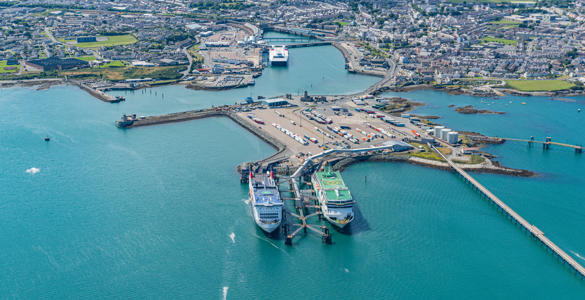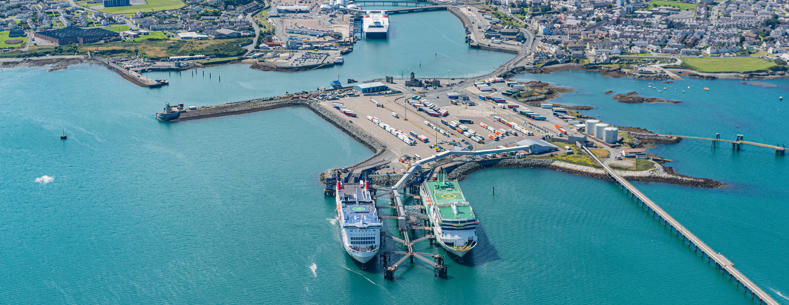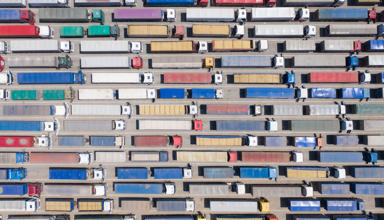Wales faced the brunt of Storm Darragh on 6 December 2024, with a red weather warning in place from the early hours of 7 December indicating a risk to life.
Two ‘berthing incidents’ involving Irish Ferries vessels on 6 and 7 December saw both ferry terminals at Holyhead Port close weeks before Christmas. While Terminal 5 reopened on 16 January, Terminal 3 is not expected to reopen until 15 July, a two-week delay from the previous proposed reopening date of 1 July. Stena Line explained this is “Despite great cooperation and the best efforts of all involved in this complex project”.
The Economy Trade and Rural Affairs Committee’s (ETRA) report criticised the Welsh Government’s response. The Welsh Government accepted none of its six recommendations, rejecting three and partially accepting the rest.
On 2 July, the Senedd will debate both the report and the Welsh Government’s response.
A “sluggish” initial response
Closure of the UK’s second busiest ferry port caused significant disruption to international trade flows and the local economy.
Yet the Committee found the initial response “sluggish” with “poor communication”. The Irish Road Haulage Association (IRHA) criticised the Port’s response as “dire”. It noted remediation didn’t begin until after Christmas and said, with over 1,000 trailers building up around Holyhead, it was “a week before we knew [the port] wouldn’t be reopening”.
Holyhead Port explained how the storm delayed work to understand and address the damage.
The Committee also considered the Welsh Government’s response slow. It noted the Road Haulage Association’s (RHA) evidence that Transport Scotland and other Scottish stakeholders engaged first on 11 and 12 December while “….the first contact that I had with the Welsh civil service throughout this whole process was that I got an e-mail on Christmas Eve, giving me an update on the port.”
It was clear that the Welsh Government had engaged with other stakeholders, like the Irish Government, throughout. And a Welsh Government official stressed their focus was on communications with drivers approaching or at the port, to manage traffic flow. However, the RHA felt it was important that freight bodies are able to disseminate information on behalf of Government.
Despite establishing a “multistakeholder taskforce” in response to the closure, the Welsh Government rejected a recommendation to conduct a “lessons learned” review. Noting the work of the taskforce, it stressed that the “ports in Wales handling Irish Sea traffic are commercial entities either privately owned and operated or Trust Ports”.
The timeline below shows key developments since December:
6 - 7 December
Storm Darragh hits the British Isles. Ferry Terminals 3 and 5 are damaged. The port closes from 7 December.
6 - 7 December
Two ‘berthing incidents’ involving Irish Ferries vessels occur on 6 and 7 December.
12 December
The Irish Government issues information on the closure, referencing contingency planning, alternative routes etc.
12 December
The RMT Union writes to its Stena Line members regarding working practices during the red weather warning, as well as rotational changes / moving staff “involuntarily” to other ports.
13 December
Stena Line says services are cancelled until Friday 20 December. It contacts customers and puts extra services in place from Fishguard and Birkenhead to Dublin, and from Cairnryan and Heysham to Belfast.
13 December
An Irish Government press release says its transport ministers have been briefed, have written to the Cabinet Secretary for Transport, Ken Skates MS, to arrange a meeting, and would write to the UK Secretary of State.
14 December
The Irish Road Safety Authority and Irish DfT announce relaxation in driver hours rules from 14 to 27 December.
15 December
The Irish Government announces a ministerial meeting with the Cabinet Secretary for Transport, Ken Skates MS, with later meetings planned with the UK Secretary of State and talks with Stena Line and Irish Ferries.
16 December
Stena Line reports that it’s been working “at pace” to secure extra capacity – referring to a new Heysham-Dublin freight route and Birkenhead-Dublin car / passenger route from 17 December.
16 December
The Road Haulage Association (RHA) says it’s working with Transport Scotland and the UK DfT to secure a temporary relaxation of driver hours restrictions from 15 to 20 December.
16 December
The Irish Government says it met again with Welsh Ministers, Stena Line and Irish Ferries, and separately with logistics stakeholders.
17 December
Stena Line announces reopening won’t take place “until at least 15 January”.
17 December
A joint Welsh Government and Irish Government communiqué is issued.
17 December
The UK DfT announces a further relaxation of driver hours rules until 23 December.
18 December
Anglesey Council’s press release says it’s offered to support Stena Line “in any way it can” following the closure, and that its Economic Development Unit will launch an online portal to engage local businesses and assess “economic and employment impacts” in January. This stays open until 31 January and written evidence from Anglesey Council to the Committee details the results.
19 December
Stena Line reports that HMRC says its “Customs Declaration Service (CDS) and Goods Vehicle Movement Service (GVMS) systems continue to operate without issue” and that hauliers would not be penalised for using routes via Fishguard, Birkenhead and Heysham while Holyhead remains closed.
20 December
A Welsh Government press release publicises additional Stena and Irish Ferries services, specifically a new Irish Ferries service from Fishguard beginning today.
20 December
An Irish Government press release says the Taoiseach (the Irish Prime Minister) has met with the First Minister, Eluned Morgan, and planned to do so again in the New Year.
23 December
A Welsh Government press release stresses “unprecedented efforts…to get people home to Ireland before Christmas.”
23 December
An Irish Government press release updates on a ministerial meeting with logistics and ferry stakeholders. On financial support, it says assessing the impact on the sector will “take some time” to “determine an appropriate response”.
27 December
The Irish Road Safety Authority and the Irish DfT announce an extension of the relaxation in driver hours rules in from 28 December to 12 January 2025.
7 January
The Cabinet Secretary for Transport, Ken Skates MS’, oral statement announces the establishment of a Welsh Government multistakeholder taskforce. It details efforts to provide additional capacity and work with Anglesey Council / stakeholders to monitor impact on local businesses. A Welsh Government press release accompanies the statement.
8 January
The Secretary of State for Business & Trade, Jonathan Reynolds MP, writes to the Chair of the House of Commons Welsh Affairs Committee. It's clear from the letter that the UK Government is feeding into a Welsh Government-led response.
9 January
Stena Line confirms that “the timeline for reopening the Terminal 5 ferry berth by 16 January 2025 remains achievable” subject to weather conditions.
10 January
An Irish Government press release indicates that the Taoiseach had again met with the First Minister, and that the First Minister had said she would “ensure the representation of Irish interests” on the taskforce.
15 January
The Committee holds its draft budget 2025-26 scrutiny session with the Cabinet Secretary for Economy, Energy and Planning, Rebecca Evans MS.
16 January
Terminal 5 reopens. An accompanying Welsh Government statement says the port was “once again open for business at full capacity”. A press release is also issued.
23 January
Both Cabinet Secretaries write to the Committee with an update on the incident.
3 February
The Committee publishes its draft budget 2025-26 report calling on the Welsh Government to confirm if any changes will be made to its export support budget to support affected businesses. The Cabinet Secretary for Economy, Energy and Planning, Rebecca Evans MS, later rejects this recommendation, saying that the budget won’t be used for this purpose but that the Welsh Government is:
continuing to explore potential additional support and we will update the committee in due course.
4 February
Media reports indicate the Irish Road Haulage Association and its members are frustrated at the speed of the Irish Government’s response on compensation, suggesting diversions had cost approximately €1,500 per load. The IRHA reportedly said the previous Transport Minister confirmed in January that support would be provided.
5 February
The House of Commons Welsh Affairs Committee holds an evidence session on the impact of the closure, partial reopening and support for local businesses and supply chain.
17 February
Media reports suggest Terminal 3 “is on course” to reopen on 1 July.
6 March
The Committee holds its inquiry, Holyhead Port Storm Damage and Closure.
27 March
The first meeting of the Welsh Government’s Irish Sea Resilience Taskforce is held. Its terms of reference are published on 10 April.
3 April
The Committee publishes its report, Holyhead Port storm damage and closure: Initial findings.
10 April
The Welsh Government publishes its Irish Sea Resilience Taskforce terms of reference.
8 May
Stena Line confirms Terminal 3 is on course to fully reopen on 1 July.
15 May
The Welsh Government responds to the Committee’s report.
4 June
The Committee publishes the Welsh Government’s response.
2 July
The Senedd will debate the Committee’s report and Welsh Government's response.
15 July
The port is expected to fully reopen.
Witnesses unsure who was in charge
Stakeholders giving evidence were unable to say which Cabinet Secretary was in charge. While the Cabinet Secretary for Transport and North Wales, Ken Skates MS, led the response, the Welsh Government website makes clear that the Cabinet Secretary for Economy, Energy and Planning, Rebecca Evans MS, has responsibility for “ports policy, including freeports”.
In evidence, she subsequently explained that she is responsible for “the contribution that ports and aviation make in relation to economic growth and stability”, while the Cabinet Secretary for Transport and North Wales “has responsibilities in relation to transport matters more generally”.
The British Ports Association said it didn’t have a problem communicating with both Ministers, and had “non-siloed” access to officials. However, the Committee recommended the response to future large scale incidents should have “a Ministerial lead who will oversee and be held accountable for management of the response”.
Despite being good practice – for example the UK Government’s Amber Book on crisis management stresses that “having clear leadership from the onset of a crisis is a prerequisite for an effective response” – the Welsh Government rejected this recommendation.
Trade diversions
The Committee noted that 104 sailings a week were lost as a result of the closure and traffic had to be redeployed to other routes. Dublin, Northern Ireland and Rosslare benefitted from these diversions, absorbing 45%, 30% and 25% of diverted traffic, respectively.
The Cabinet Secretary for Economy acknowledged that, while the data needs “unpicking”, the value of trade though Holyhead in December 2024 was almost half a billion pounds less than the year before (-£490.4m).
And while logistics expert, Professor Andrew Potter, didn’t foresee a long-term reduction in trade, the Committee was concerned that the closure “may have further exacerbated” post-Brexit diversions away from Welsh ports to ports in Scotland and England. It concluded that the Welsh Government “must use all available levers to ensure Holyhead remains an attractive choice”.
Local economy hit by closure
The Isle of Anglesey County Council said “the importance of the Port of Holyhead to the local and Welsh economy cannot be underestimated”. Cybi Business Forum noted that passenger numbers are key for local businesses, as “the footfall through the town and the spend through the town is what keeps businesses going”.
The Council highlighted that footfall in Holyhead town centre during the closure was down 37% compared to the previous year. Some local businesses reported trade was down by 90% during the closure, with the transport, retail, storage and accommodation sectors most affected.
The Committee was relieved to hear that the impact of the port’s closure had not led to the anticipated level of job losses in affected local businesses. However, it was concerned about the lack of understanding of impacts on the local workforce. The Welsh Government acknowledged gaps in the data on this, and will consider how to address this with local partners.
The Committee also called for the Welsh Government to urgently make a decision on what support it would provide to affected businesses. The Welsh Government’s response says it has “responded positively” to business support proposals from the local authority, and will work with it to “develop and agree funding so that these actions can be implemented as swiftly as possible”.
The taskforce and beyond
Following a Welsh Government meeting with the Irish Government, the taskforce met for the first time on 27 March 2025. The terms of reference indicate broad membership and a focus on: contingency planning; current and live projects; and future developments.
The Committee outlined a number of areas it felt the taskforce should consider, including “supporting the long-term viability of the Port and avoiding future trade diversion”.
The Welsh Government partially accepted this, noting again that the port is privately owned and that “the long-term viability of the Port is a matter for Stena Line.” Despite this, the terms of reference state:
The taskforce will ascertain what Holyhead and other Welsh ports need from all stakeholders over the longer term, to not just survive, but to thrive.
The Welsh Government’s National Transport Delivery Plan promised a Welsh Ports and Maritime Strategy and Wales National Freight and Logistics Plan by 2024. Previous evidence to the Climate Change, Environment and Infrastructure Committee indicated the Ports Strategy had been deprioritised in favour of the freight strategy, yet ETRA noted that neither has materialised. The Cabinet Secretaries explained how these would now integrate with the taskforce work.
Noting disappointment among some stakeholders at this delay, the Committee recommended this should be “expedited” once the taskforce has completed its work.
While the port is now expected to fully reopen on 15 July 2025, the incident has raised issues that will take longer to resolve. The taskforce’s conclusions, and their implementation, will be critical to the future resilience of the landbridge connecting the island of Ireland to Great Britain and beyond.
Article by Andrew Minnis, Sara Moran and Gareth Thomas, Senedd Research, Welsh Parliament






